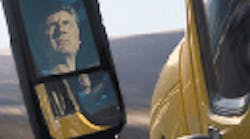Although texting while driving by truck drivers has become a major safety concern for the trucking industry, a new report on “secondary tasks”—that is those not related to the primary tasking of driving the truck— reveals a length laundry list of actions taken by truckers while under way. The drivers studied were videoed in their cabs and the behaviors captured document what life on the road is like for many of today’s linehaul and P&D drivers.
Back in November of 2005, the U.S. Dept. of Transportation and a private consortium led by the University of Michigan Transportation Research Institute (UMTRI) began a multi-year project to develop an “Integrated Vehicle-Based Safety System” ( IVBSS). One result of the ongoing initiative is the recently publicly released “Heavy-Truck Field Operational Test Key Findings” report.
As part of the IVBSS program, participating drivers were videoed while behind the wheel to see what activities not directly related to the job of driving they engaged in, such as talking on a cell phone, eating, smoking or adjusting various in-cab devices.
The resulting considerable list of the so-called “secondary tasks” recorded may be almost as useful as the testing of the safety systems themselves for what it reveals about work life on the road.
Here is an abbreavited version of the list:
- Dialing the phone
- Text messaging
- Talking/listening on the phone
- Talking on or holding the CB radio
- Talking to or looking at passengers
- Adjusting stereo controls
- Adjusting HVAC controls
- Adjusting other controls on the dashboard
- Adjusting the satellite radio
- Adjusting the navigation system
- Holding or adjusting other handheld devices
- Writing on or reading the manifest
- Eating
- Drinking
- Grooming
- Smoking
- Reading
- Writing
- Searching the cab interior
Secondary tasks related to communications were the most common (20.7%), followed by eating (9.7%). According to the report, “Drivers with their windshield wipers on were the least likely to perform secondary tasks, while driver at night were the most likely to perform secondary tasks.”
When the study broke out the results from P&D drivers and linehaul drivers, however, researchers did find a key difference: “In general, [P&D] drivers in more complex driving environments( on surface streets, in bad weather) were less likely to be seen performing secondary tasks,” the report stated.
“Conversely,” the study also pointed out, “linehaul drivers on highways at night experience low traffic over long, continuous periods. While P&D drivers may be able to snack between stops or make a phone call while making a delivery, linehaul drivers eat and communicate while driving, both to break up the monotony and to maintain alertness.”




